#tmc_engaging
Explore tagged Tumblr posts
Text
Essay #14: Trails series – Worldbuilding of The Now
<Link to Essay #14>
0 notes
Text
Essay #13: Slow Play
<Link to Essay #13>
0 notes
Text
Essay #12: A Short Walk Through New Vegas’ Wasteland
<Link to Essay #12>
0 notes
Text
Essay #11: Introspective Roleplaying: CRPGs as Reflective Playgrounds
<Link to Essay 11>
0 notes
Text
Essay #10: Layers of Magic Circle: the Intended Design and the Player’s Design
<Link to Essay 10>
0 notes
Text
Play #9: Talisman’s emergent narrative: making meaning out of chance
A few weeks ago, I played Talisman: Digital Edition with my friends. As its name suggests, the game is a digital adaption of Games Workshop’s classic board game from 1983, Talisman. The game’s main objective has players taking turns rolling dice to travel around the gameboard, fighting enemies and collecting loot before they can venture into inner zones to become the winner. Indeed, if that description hasn’t reminded you of a typical RPG’s gameplay loop yet, then the fact that the game’s aesthetic theme is western fantasy should cement that. That being said, the board game is definitely not meant to be a storytelling-focused game like Dixit or the typical Tabletop RPG; none of Talisman’s rules mentions nor encourages players to tell a story as they play along. Yet nevertheless, the emergent narrative formed unintentionally through our playing was what made the game really fun for us.
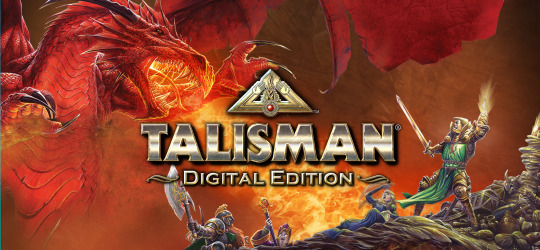
This emergent narrative caught my attention when after we finished our first session, one of my friends said that the campaign was fun and then proceeded to describe the experience in fantasy narrative style. To call our session a “campaign” reminded me of Dungeons & Dragons (my friend knows a little bit about DnD), and when I looked back to our playing session, our Talisman session did feel similar to a fantasy adventure: we worked together to take down the Sentinel, we kept losing our healths inside the harder areas, we made fun of each other when our lucks weren’t in our favor, and so on. The game was already fun to play as it was, but by describing the session in terms of DnD style, we also produced a fun story too. For example, this was our most favorite moment in our first session:
Reality: I accidentally lost my last Life Point by not paying attention. Unexpectedly, that death gave me a chance to turn the game around. When I got revived, I got lucky and drew a spell that lets me steal a powerful item from my friend. This one singular decision ended up having a big ramification to the point of leading me to victory.
Narrative: The Exorcist visited the graveyard to make a pact with the Devil. In exchange for his life, he gained immense power that let him steal a powerful artifact from his ally—a wand that lets him cast numerous spells. With this newfound power, obtaining the Crown of Command was an easy task for him.
Notably though, the way we created narrative here was slightly different from roleplaying: instead of acting in alternate persona in order to form a narrative, here, the narrative was formed retrospectively. None of us played the game with the intention to tell a story, and yet we nonetheless looked forward to the kind of absurd narrative that could be generated from our playing.
One specific feature of Talisman that contributes the most to the creation of this emergent narrative is the matter of “fortune”, a central point of playing according to Sarah Lynne Bowman. While Talisman has been met with criticism before for being too luck-based, I think half the fun of the game is dealing with bad luck. The unpredictableness of dice rolls opens up opportunities for us to laugh at each other’s misfortunes or to get surprised by an unexpected turn of event. Granted this randomness might not be fun for everyone, but for my friend group, who loves “stories so absurd it is fun” (it’s the reason we watch Riverdale weekly), Talisman is perfect for us! Even boring moments can be translated into something memorable, such as with our second run. New to the game, we were unaware of the Firelands Expansion’s difficulty, so our combination of the expansion with a specific victory condition that did not gel well ended up making the run horrible. To put it plainly, we had to end the run prematurely because it was miserable to keep playing when everyone just died every turn due to fire tiles. As a story, however, it was frankly entertaining to look back on: just a bunch of heroes who failed to save the world from hellfire, so they slowly burned in hell for their damnation sins. This sort of emergent narrative, which is resulted from unpredictable dice rolls and our interpretation of events, demonstrates the power of narrating: it can turn individual gameplay moments into a meaningful sequence.
Overall, I find it interesting that this emergent narrative is “forcefully” constructed by the players instead of being a natural part of the game’s convention. In a way, such a narrative making process can serve as an example of how players' experience doesn’t necessarily have to correlate to a game’s intended design in order for them to have fun.
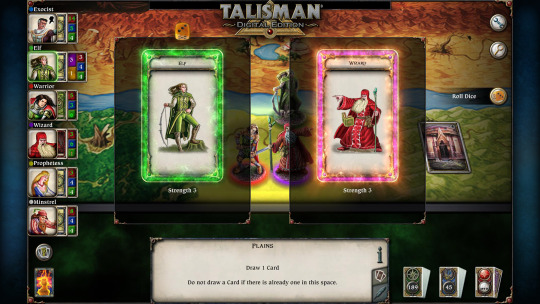
P/S: I wonder what it would be like to play Talisman as a roleplaying game?
0 notes
Text
Essay #9: The Blasphemy and The Triumph in Dismantling Video Game’s Sacred Circle
<Link to Essay #9>
0 notes
Text
Play #8: Beating for the sake of beating?
One of the things I’ve come to appreciate lately is the joy of beating the game for the sake of it. I used to believe that to enjoy a game to its fullest, I have to experience as much content as I can: all of its side quests, all of the optional minigames, all of the secrets, and so on. The thought of skipping these contents rarely crosses my mind, in part because I thought I would have a lesser experience; after all, doesn't the journey through the game matter more than the destination? Yet, such obsession with “full experience” was perhaps one of the reasons I soured my experience with some games by forcing myself to slog through parts I didn’t like. Thankfully, I’ve gotten better at understanding why I enjoy playing video games, so I’ve left that mentality in the past. Sometimes it is nice to just prioritize my own enjoyment over experiencing everything; that’s what I did with Legends of Amberland, Victor Vran, and Trine series, and what made me love these games a lot, enough that I want to replay them properly one day. Had I forced myself to experience everything in these games (in particular with Trine’s late-game difficult puzzles), I knew I would have gotten burned out sooner or later.
This priority reminds me of how I used to play with toys back in childhood. Here, I optimize my own enjoyment first and foremost, while disregarding the game’s intact cultural or artistic value. My goal is to relax through engaging with the game’s content: to puzzle out the solutions, to laugh at the humorous writing, to enjoy an epic story mindlessly, to have fun overcoming a combat challenge, and so on! And once I begin to feel bored with the game, I just rush into the ending instead of forcing myself to play further. If I am playing simply to entertain myself, not to evaluate how well-crafted the game is, there is nothing wrong with not experiencing all the contents so long as I feel entertained the whole playthrough, isn’t it? The key lesson is that I should not feel guilty for not experiencing everything fully; there is always next time.
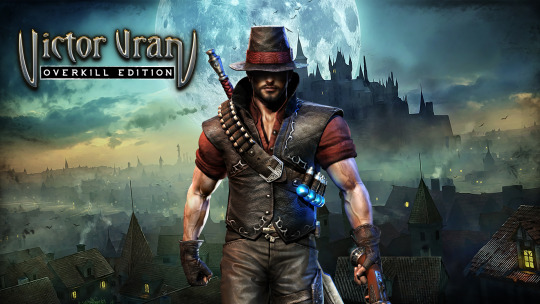
Still, why do I need to beat a game first in order to consider my whole playthrough to be fun, I wonder? There are times when a lack of proper conclusion often leaves me feeling empty, but I never thought hard about why a conclusion is important to my enjoyment. For example, while I do enjoy playing open-ended life-sim games like Animal Crossing: New Horizons or Stardew Valley, I usually get bored eventually, which in turn sours my feeling toward them even if I had fun playing them before that. I feel the same struggle with roguelike games despite my liking of their gameplay. In a way, the only way I could feel satisfied from playing these games is to establish an end goal—something to stop my engagement before boredom takes over. Take Dead Cells for example, I set my end goal to be beating the seventh level Astrolab, so when I reached it, I was left satisfied and had not touched the game since.
Additionally, there were times when I could feel this same satisfaction even though I "finished" a game through an alternate means instead, such as through watching a YouTube video. This was the case with Utawarerumono: Mask of Truth. As the final battle was too difficult for me, I had to resort to a YouTube video to see the ending. Similarly, I couldn’t finish Yakuza 0 in game because the game constantly froze at the final boss cutscene on my old lap, so watching the ending online was my only option to conclude “my” playthrough. Even though I didn’t “earn” such an ending, I still felt a similar sense of accomplishment, or joy, that came from beating a game. What is this satisfaction that comes from beating the game? Could the answer be as simple as because finishing a task is fun?
What’s more, I’m also curious if my urge to reach the end of a game at all cost is inherent to my mind, or if it is learned as a consequence of consumerism. By consumerism, I referred to the behavior of hoarding games that has been normalized in gaming culture. Everywhere I go on the internet, jokes about the endless backlog are everywhere; it’s fairly common for someone to take pride in cleaning their backlog (including me), as though video game is something to get through, not to experience. Putting it that way, I can’t deny the possibility that one reason I enjoy rushing to finish a game is because I want to clear my backlog: to put the game out of my mind so I can focus on something else. Even so, the reality here is that I only love the Trine series as much as I do right now precisely because I rushed to the end instead of forcing myself to play the parts I didn’t like. Perhaps it is unwise to conclude that the urge to rush to the ends should be unlearned simply because it can be associated with consumerist mentality.

Lots of questions opening up with little answers… I will have to revisit this topic another time.
0 notes
Text
Play #7: Let’s Play as an adaptation?
Back in Play #4, I mentioned the idea of watching YouTube’s Let’s Play as a curated linear experience, but I didn’t think much yet about the value of the commenter. It’s not because I dislike commentor or something, but because I thought they would distract me from getting absorbed into the game. Upon watching the Let’s Play series of Siren (by supergreatfriend) and Mizzurna Falls (by iconoclast187), not only have I come to appreciate the value of well-informed commentary, but doing so also gives me a few thoughts on the peculiarity of translating video game’s interactivity into linear format.
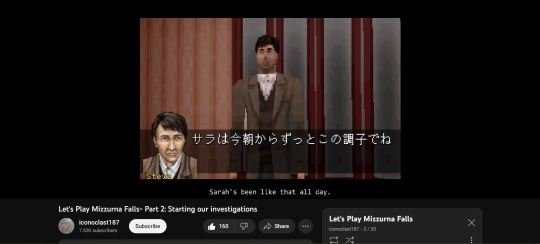
Part of the reasons I chose to watch Siren and Mizzurna Falls over playing them by myself was because these games are notorious for their difficulty. For Siren, the difficulty comes from the amount of bizarre hidden objectives and strict stealth missions. Meanwhile, solving the mystery in Mizzurna Falls requires players to know exactly where and when each event will occur if they want to get there in time to gather clues. In a sense, these difficulties encourage players to slowly figure things out across multiple playthroughs, but for someone who is not into that kind of game design, watching Let's Play was a better choice for me. At first, I planned to watch a no commentary or a blind playthrough, but out of curiosity I figured why not watch a playthrough by a skilled player instead? Turned out, that was an amazing decision.
What I’m most impressed about the commentary in these videos is that it walks a fine balance in pointing out obscure mechanics or story details that most players will miss, but not overdoing it to the point of ruining viewer’s surprise. For example, because both games can be dense to follow with their multiple plotlines going on, both commentators often explain various minor connections between characters, but they never deliberately give away direct answers to the mystery. Unlike a blind playthrough whose appeal is the commentator's reaction then, these Let’s Play videos focus more on showcasing the in and out of the game; the commentators act more like a tour guide to the viewers. This comparison applies the most to Siren's case: supergreatfriend often mentions various external media around the game, such as the game’s official website and its sequels, to give the audience an overview of the series’ history. Honestly, I don’t think I would appreciate these games as much if I played by myself; I wouldn’t notice all the fine details in these games, nor do I have the skills to enjoy their gameplay.
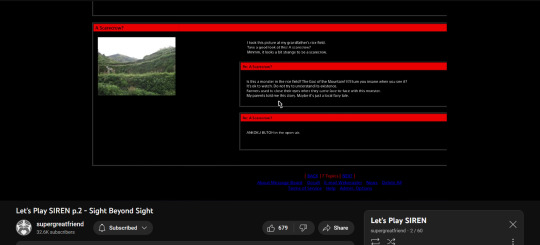
Such struggle also makes me realize that engaging with video games requires more skills from consumers than other mediums such as books or movies. For someone who has played video games since childhood, playing games has become a second nature to me, but for many people, it is definitely not. Razbuten’s What Games Are Like For Someone Who Doesn't Play Games video, for example, really shows the amount of skills required to properly engage with a video game. In the same way that such skill requirement is important to some video game’s identity such as Dark Soul, that difficulty can inadvertently alienate a lot of people from truly appreciating video games also. Watching a Let’s Play, especially ones accompanied by well-informed commentary, can allow viewers to appreciate the art of video game design even if they themselves don’t have the necessary skill to play it by themselves. Nothing can replace the experience of playing the game by yourself, of course, but Let’s Play does offer an alternative experience, one that, I think, bears resemblance to experiencing a work through an adaptation.
In a way, watching a Let’s Play video reminds me of watching a TV adaption of a book. The comparison is odd, indeed, but I do think there are some merits to it. At the end of the day, most Let’s Play videos are not pure, unedited footage; they were recorded, cut, and edited into a specifically curated experience first before they get published online. The videos thus remain containing elements of the original work (the gameplay footage), but also offer a new experience in mind (such as entertainment). For example, turning Siren and Mizzurna Falls into a linear video format does rob their interactive gameplay away, but in exchange, the commentary accompanying these Let’s Play series do teach the viewer about the game series’ artistic values in a way that playing the game by myself does not. To put it another way, Let’s Play series is half-original, half-not.
I suppose the biggest question I want to raise in this post is this: how are these “adaptations” different from common adaptations like movie or TV Show adaptations, outside of the biggest difference being that Let’s Play videos are made by hobbyists? Of course, these kinds of “adaptations” created by hobbyists do not undergo the review processes nor have that “professional feel” that official adaptations would have. Likewise, if I go by Oxford Reference’s definition of adaptation—”the process of making a work of art upon the basis of elements provided by an earlier work in a different, usually literary, medium”—then most Let’s Play videos probably won’t fit since they lean more toward entertaining and/or educational (documentary, perhaps?). Nevertheless, there is no denying that a lot of thoughts, and artistic sense even, get put into the process of turning raw gameplay footage into accessible videos, not to mention making commentary is an art in itself. Furthermore, it is significant that this presentation style has a strong public demand too. Despite being able to play the games by themselves, many people willingly choose to watch a Let’s Play instead precisely because they prefer that kind of experience; this was what I did with Spirit Hunter: NG. I wonder if the bigger question I have here is that what if watching Let’s Play is not an inferior experience compared to playing, but an equally alternative experience in itself? Isn't this sort of experience the reason people are drawn to adaptation?
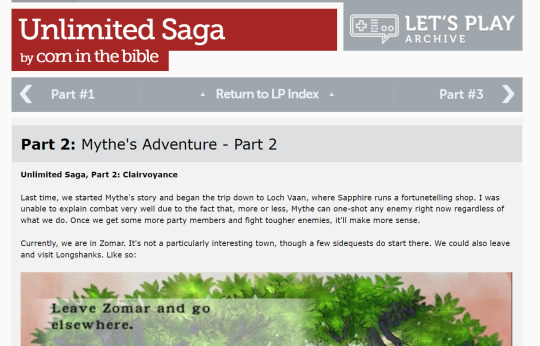
P/S: The most surprising thing about Let’s Play for me is that before the video format even became popular, text Let’s Play was already been a thing; Let’s Play Archive features a gigantic collection of these Let’s Play if you want to check it out. The act of translating a visual medium into a text medium with numerous screenshots is so fascinating. Not only do the commentators have to adapt a lot of visual and audio features into text format (such as dialogue boxes), but they also have to be selective about chosen screenshots; no one likes “reading” a wall of endless screenshots. It sure takes a lot of skills to make Let's Play, whether in text or in video.
0 notes
Text
Essay #8: CRPGs and the Self: An Introduction to Introspective Roleplaying
Usually, I avoid writing long essay back to back in order to give myself sometimes to think, but finishing Dragon Age: Inquisition last weekend motivated me to work on this essay, which deals with the idea of using solo roleplaying to do introspection. It is built upon the concept of playing for one's own sake that I discussed in Essay #7 as well as my own experience with roleplaying in CRPGs. In a way, this essay also serves as an comprehensive piece about my current understanding of roleplaying's values, or more specifically solo roleplaying's.
Since I'm planning to write more about introspective roleplaying, new to this blog is the tag #tmc_roleplaying. I look forward to turning CRPG genre into something special for myself!
<Link to Essay #8>
0 notes
Text
Essay #7: Experiencing for Self & Experiencing for Others
My latest essay about the idea of experiencing for my own sake versus experiencing for others’ sake is up. It feels really nice finally working out why I enjoy fiction so much as well as coming up with new studying plan. I can say for sure that if I follow my new experiencing motivations listed in the essay, I won't ever experience a huge burnout from fiction ever again.
As usual, I will take a break next week to work through my reading backlog, mostly essay collections. I think I already have a good idea of what to write next, but it wouldn't hurt to do a little bit more research.
<Link to Essay #7>
#tracingtheculpritstrack#tracingthemagiccircle#tmc_engaging#tmc_essay#tct_personal#tct_essay#tracinginward_essays
0 notes
Text
Play #6: The Magic Circle of Just Dance
I know in my latest essay I said that I would stop talking about “Stupid Media” for the time being, but my recent renewed obsession with Just Dance makes me think it would be a fun to talk about the silliness of playing a dancing video game; nice change from all that talk about video game narrative lately.

Most people have probably heard about Just Dance, Ubisoft’s dancing video game series that is famously known for its continuous release on the Wii even when Wii U and Nintendo Switch already made Wii obsolete; Just Dance 2020 in particular was the final Wii game that was released physically in North America. Its gameplay is as simple as it gets: the player dances to the choreography on screen, earning points by performing the correct moves. The song list is generally made up of a mixture of classic songs as well as modern ones, and aesthetic-wise, the game’s choreography videos are very colorful and energetic. It is a fairly simple formula, but it works well enough that the series has continued releasing new entries yearly. Due to its casual nature, I am not surprised that conversation about the series rarely occurs in gaming discussion; I suppose that as the game gets released yearly with the same old formula and all, not much more can be said about the series’ evolution in gaming design (outside of upgraded visuals and more complex dancing moves). But despite all of that repetitiveness, Just Dance continues to be a fun part of my life for nearly a decade now, and so I think it would be fun to examine why it is fun to me. The simplest answer is that it is just fun to dance to colorful music videos! But after some thinking, I think there are a few more reasons to that, which I can chart it up to the power of playing inside a magic circle.
One of the ideas that comes to my mind right now is Theorizing Stupid Media’s concept of bodily stupid. In the chapter “The Stupid as Ludonarrative Dissonance”, the book mentions that one of Pokemon GO’s appeal might be explained by the way it forces players to move their body weirdly: “One of the things that Pokémon GO illustrates is that the stupid is not singularly located in the media referent, but rather in the reception of the body. The way that we respond to watching other bodies (mindlessly) twist, tumble, fall, relent to gravity, or confront the concrete realities of space, geography, architecture”. But more importantly, such bodily stupid often evokes a desirable reaction: “it is the uncontrolled flailing body in a Pokémon GO fail that elicits a different affective response—laughter”. Such laughter, I think, is one of the reasons I’m drawn to Just Dance to this day.
As much as I love Just Dance, I have to admit that most of the choreographies are not designed to elicit a sense of professional dancing, at least not the kind of acceptable forms of public dancing like salsa, ballroom, and hip hop, in part because of the series’ casual vibe. As the series is supposed to appeal to all ages, the choreographies in general are often repetitive and simplistic. Back when Harmonix's Dance Central was still a thing, people often compared its complex dance choreographies to Just Dance’s as a way to make fun of the latter’s simplicity. Nevertheless, the series’ casualness is also what makes it perfect to play at a party! I still remember how these games were often a blast at my parties; there were laughter from my friends who flailed around, trying to match up to the choreography, as well as from those who just had fun watching the players fumble badly. Those joys occurred through the bodily stupid produced by the game. In a way, even though we laughed at each other’s clumsy movements, it was not with the intention of making fun of them, but more so in the shared joy of playing. I wonder if this is a similar principle behind party games that involve body movement like Twister?
In a way, Just Dance’s great strength is its casual approach to dancing, from its vibrant visuals to ease of use. Even people who are unfamiliar with gaming can easily play the game by themselves; all they need to know is how to open the game, select a song, and dance to it. Moreover, no matter how badly the player performs, the game’s positive vibe doesn’t berate them for failing, but encourages them to try again. In game studies terms, I could say that the playful atmosphere of the series forms a magic circle for people to dance to their heart's content without being made fun of; a safe space to explore the joy in dancing even if you are not good at it (me!). It is funny to compare dancing to Just Dance to the idea of live-action role playing (larp for short), but I think Stenros and MacDonald’s quote that describes the joy of larping also applies to playing Just Dance: “They are beautiful to do, but not necessarily interesting to watch”. Yeah, I may fail to dance well, but it is the attempt to dance to my heart’s content that makes Just Dance fun for me! It is this kind of joy that makes me return to the series, solo or with friends, for nearly a decade now.
Thinking about Just Dance as a magic circle also gives me some thoughts about the values of the circle itself. After all, Just Dance is the kind of game that technically can work even without the medium; one can simply play a YouTube video of the game and dance to it. But such imitating typically lacks the value of immersing into the magic circle and respecting the game’s rules. By following the game’s immersion rule—I have to move my entire body even if the game only tracks my hand movement through “larping” tools such as a joy-con or my phone—I enter into a safe space that allows me to dance badly without getting made fun of. I suppose, the value of playing inside a magic circle is that it allows one to safely explore a concept that is outside of their comfort zone without getting berated. Without a magic circle, playing is simply imitating, an act that is often frowned upon in societal rule. There is still a lot more to look into about the powers of dancing and the rules of magic circle, but I will stop this essay for now. I can say for sure that I don’t see myself losing my love toward Just Dance series any sooner (well, maybe if they increase Just Dance Now’s subscription costs…)
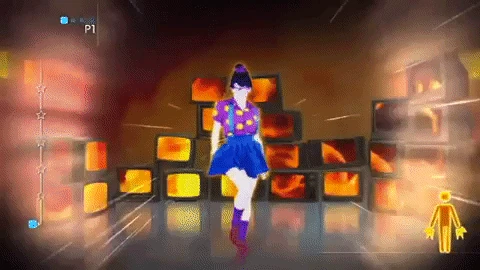
P/S: Stefanie Heinzmann’s Diggin' In The Dirt is such a great motivational song to dance to every time I ever feel down.
0 notes
Text
Essay #6: Choose Your Own Stupid Adventure, Make Your Own Meaningful Fun
My new essay is finally up! It has been really fun rethinking about my engagement with nonlinear RPGs' narrative systems. Looking forward to see how I can further expand all of these ideas in the future.
For now, I will take a break next week to read more essays about video games and detective fiction. I haven't read anything lately.
<Link to Essay #6>
0 notes
Text
Play #5: Protagonist system in nonlinear RPGs: instance versus system?
As a follow-up to Play #3 and Play #4, this post aims to dig deeper into a topic that has been on my mind lately: on how to analyze the narrative roles of customizable protagonists in RPGs; by customizable protagonists, I refer specifically to undefined and semidefined protagonists which I tried to categorize in Play #3. In Play #4, I mulled over how RPGs with nonlinear narrative systems can make it difficult to analyze a game’s overarching narrative without reducing it to a linear format. Notably, these nonlinear RPGs usually feature customizable protagonists as well to increase player’s freedom to interact with the narrative. In a similar manner as the fragmental narrative system, these customizable protagonists also offer extensive malleability to their characterization, and with a similar consequence, the difficulty in analyzing their roles in the overarching narrative also increases tenfold.
Let’s talk about undefined protagonists first. Protagonists are the driving force of narrative, so when they are blank state, how can I best interpret their role in relation to the narrative the best?
If I take these protagonists as they are—as plainly written characters—the conclusion about their involvement with the narrative seems obvious: being blank means they have little emotional reaction to the story’s events, which can in turn lessen the story’s emotional beats. Do notice that undefined protagonists are different from silent protagonists in linear narrative. Whereas narratives with silent protagonists are often designed to work in tandem with that silentness, meaning that the story still has strong emotional beat (See: Ys game series), narratives with undefined protagonists may not be able to take player-created characterization of these protagonists into account; after all, player’s imagination is endless. In short, if we treat undefined protagonists exactly as how they are presented, blank-state protagonists can make for a boring story because they are simply underwritten and may have little personal attachment to the game’s overarching narrative.
Second, if I am to treat them as simply a self-insert avatar, the narrative is unlikely to be satisfying for me as I, the player, is inherently separated from the game’s world; I have zero personal stake in the game world unlike the fictional characters living inside there. In a sense, self-inserting reaffirms at every moment that I am only playing a game. Self-inserting does open up a lot of questions in regard to the relationship between gameplay rewards, narrative rewards, and player’s own want, but as I am focusing mainly on the protagonist’s supposed role in the narrative right now, I will disregard self-inserting for the time being.
The third possibility that I have in mind right now is roleplaying. By roleplaying through undefined protagonists, I essentially create a player-created predefined protagonist; they are like regular predefined protagonists, except the author in this case is not the game’s writer, but I, the player. Now that I have a predefined protagonist, it might be easier to analyze such protagonists since they are essentially linear now (although roleplaying does open another can of worms in relation to video game narrative…). Nevertheless, this protagonist created for roleplaying also opens up an interesting question: is such a player-created protagonist only an instance of the game’s overall… what should I call the narrative mechanic that allows me to create such an instance? “Customizable protagonist system”? I will go with that for now. Let’s reword my concern: if I can only analyze an instance of the customizable protagonist system in a particular game, does that mean that customizable protagonists cannot (or can, but not as effectively) be analyzed by how we generally view protagonists in films or novels?
Even semidefined protagonists such as Hawke run into a similar predicament of being less of a character and more as a system. Despite having a premade detailed backstory and to some extent some premade characterizations, Hawke’s subsequent development in the main story is influenced by the player. In a sense, the only way we can analyze Hawke is to analyze each instance of Hawke per playthrough. However, such instance-based analysis may mean that we are unable to analyze Hawke character as a whole, because being whole only exists in a linear story. Is Hawke then not a conventional linear character, but more as a protagonist system even though they seem more fleshed out than an undefined protagonist? I suppose, this issue does remind me of a central point in Theorizing Stupid Media: that we cannot effectively analyze video game’s unique storytelling features (in this case, undefined and semidefined protagonists) through borrowing analysis techniques from commonly linear mediums like literary studies or film studies.
One of the biggest issues this customizable protagonist system, as well as the fragmental narrative system I talked about in the previous post, brings up is that its nonlinearity makes it difficult to discuss video game narrative with others. It is easy to assume that because two people are talking about the same game (Arcanum, for example), they are talking about the same narrative experience. However, thanks to video game medium’s interactivity, everyone’s experiences can vary so intensely, not just with each individual’s narrative arrangements of main quest and side quests, but also with their own takes on the customizable protagonists. In that case, how can we minimize the differences so that we can discuss protagonist systems and narrative systems in a particular RPG with each other? Does the solution require us to assume an ideal protagonist or an ideal narrative arrangement? Certainly, one can do that and then analyze such, and many have done a lot of fruitful analysis posts from that angle. However, it is important to recognize that this is only an analysis of one instance of a customizable protagonist and a narrative arrangement world—a linear narrative analysis cannot exactly reflect the complexity of a game’s nonlinear systems. Of course, there are a lot of nuances going into this, and I know I have only scratched the surface right now, but what this teaches me is that I need to be aware of the difference between instance versus system when writing about games or discussing them with others. For example, when I say “this story sucks”, I should be more specific and say “the story I experience in current run sucks” (kind of verbose...); this still leaves room for hypothetical runs that do not suck.
The new problem that I want to leave this note on is this: how can I analyze customizable protagonist systems and fragmental narrative systems without relying on conventional storytelling analysis? Hmmm, seeing that I’m more interested in the player’s side of video game analysis right now, perhaps I should focus more on how players can make best use of these systems to produce meaningful stories for themselves. As most of my posts about video games go, I should start by analyzing my own method first!
0 notes
Text
Play #4: Narrative system in nonlinear RPGs: curating the experience?
One feature that comes with video game’s nonlinear narrative is that the overarching narrative is often told in fragmental pieces commonly known as “main quests” and “side quests”. The purpose of this fragmental storytelling is so that players can have control over the order to which the narrative would unfold; this freedom also means more often than not, no one’s playthrough is the same as another. Nonlinear reading structure certainly has existed before in book format, but they are often seen as experimental compared to the more common linear type, in which the reader is expected to read from first page to the last page. However, with video games, and especially with RPGs, this sort of nonlinear reading order is often the main selling point. In a way, this nonlinearity bears the most resemblance to old-school Choose Your Own Adventure books, but as video game’s narrative is not bound by standard book format, the freedom to rearrange the narrative pieces only gets more complex.
Take Dragon Age: Origins, for example. After the linear prologue, the game then offers the player multiple main quests that can be tackled in any order that the players want. Not only that, completing one main quest may open up more options in the remaining main quests as well. Furthermore, factoring in side quests further increases the vast amount of ways DAO’s story can unfold. While not all quests have causal relations to each other, the fact that players can choose the order to which they experience main quests and side quests is worth investigating in.
What I’m more curious about right now is in what way does this customizable narrative arrangement have an impact on the player’s own understanding of the work? In a story with linear reading order, the narrative is essentially curated by the game developers for the players to have some specific experiences (although the players can defy that). But with nonlinear reading order, picking one’s own adventure may also mean that their experienced narrative may not follow a conventional story beat structure, for better or worse. I wonder how that lack of authorial-curated experience can impact one’s enjoyment?
Then again, the capacity to curate one’s own experience can also ensure that players get what they want out of the narrative, even if their experience may go against the intended way of playing. Don’t like downtime side quests? Ignore them. Have a tired day and just want to chill? Just do all the light-hearted quests and leave the more emotionally-intense quests for another time. Or if the player just plainly does not care about the story, they can simply skip all of the story contents in order to focus on the exciting gameplay. The possibilities are endless.
The capacity to control the order in which the narrative can unfold is so interesting to think about. I should attempt to list a few ideas that come to my mind right now:
For one, how can the player curate their own playthrough if they don’t know enough about the game? Consulting guide is an option. But in that case, does using a guide essentially ask for a curated linear experience?
It is certainly possible to curate your experience on the go. For example, in my playthrough of Octopath Traveler 2, after figuring out which character’s story I like more, I generally prioritize doing the ones that I like the least first while leaving my most favorite stories to do last. This way, I can build up my enjoyment so it ends on a bang.
Does watching a playthrough count as a curated experience? Even though I owned a copy of Spirit Hunter: NG, a horror visual novel, I decided to watch a playthrough instead so I could skip through the puzzles part and head straight to the novel part.
What happens if the player does not attempt to curate their own playthrough and just goes with the flow, something like a full blind playthrough? What sort of emotion and feeling can arise from such run that a curated run can’t elicit?
Furthermore, one question also arises from this customizable narrative arrangement: how do people discuss the game with others if everyone has their own arrangement of narrative? Obviously we can discuss the game, but do we discuss it by judging its narrative pieces (main quest and side quest) individually, isolating from each other? I find that sort of discussion to be common. Generally, when we discuss a part of a story, we would discuss it in relation to the whole story, but how does that take the player's individual narrative arrangement into account? While a lot of playthroughs will certainly share similar story beats, the narrative arrangement made by the player does matter to the player’s experience of the narrative. In short, when we discuss video game narrative with others, what exactly do we assume to be the shared narrative arrangement here? Are we to treat nonlinear narrative as linear if we want to discuss a game’s overall story?
Side note: I do like that in Theorizing Stupid Media, the authors compare video games to theme parks. Would it be too farfetched if I do a quick research on how people navigate around attractions in theme parks and then try to draw a parallel to how people navigate around narrative quests in video games? Then again, it is not like there is any downside to giving this wacky idea a go (beside maybe wasting my free time).
0 notes
Text
Play #3: Three types of protagonist in narrative-driven RPGs
I wonder if I could categorize protagonists in narrative-driven RPGs into three types based on the degree of details in their characterizations:
Predefined protagonists: the most common types in JRPGs and fiction in general. They are characters that are handled fully by the authors. You can’t interact with their character arc besides watching them unfold in a linear manner. I consider most “silent protagonists” to be predefined protagonists also.
Undefined protagonists: characters I often refer to as “blank-state protagonists”. This protagonist type is generally designed to be an avatar that players can self-insert in or use as vessels for roleplaying. Thus, they rarely have preset characteristics or visual appearance in order to support the player's freedom of customization. Examples can be found in Baldur’s Gate 1 & 2, Icewind Dale, Dragon Age Origins, and Pillars of Eternity.
Semidefined protagonists: a mixture of the first two types. Semidefined protagonists are characters that come with pre-established personalities and backstories, but their further developments in the narrative are often left to the player's agency. Dragon Age 2’s Hawke comes to my mind as an example right now.
The latter two types are definitely unique to video game medium thanks to the medium’s interactive nature. This uniqueness also begs an important question: how should I understand these protagonist types in connection to video game narrative?
One of the fallacies I used to have with these two protagonist types is that I see them as worse versions of the first type in trying to treat their lack of concrete characterization as a flaw. For example, I used to take issue that semidefined protagonists can pick choices that can be wholly contradictory to their (supposed) morality. Let’s say I pick an evil decision early on, but then a good option later—won’t that be Out of Character for that protagonist in the narrative? The fact that the narrative may not even acknowledge that contradiction used to irk me. In the same way, I also thought that undefined protagonist is essentially a relic of the past where narrative in video games only serves as an excuse for gameplay action. But looking back now, I feel my approach to these protagonist types was inadequate, as I was trying to apply literary analysis techniques, ones that tend to focus on analyzing predefined protagonists, to to-be-defined protagonists. What then would be an interesting way to analyze undefined protagonists and semi-defined protagonists?
I think the answer may lie on the player's side, namely in their own interpretation of the blank state. After all, video game is a storytelling medium that actively requests the player's input—thus, it also necessitates that the player does have some responsibility when it comes to giving value or meaning to undefined and semidefined protagonists also. This necessity in player’s injection into these protagonists may be a new storytelling feature that is specific to video game medium; the players cannot just passively “read” undefined and semidefined protagonists, but they also have to actively “write” these avatars into proper fleshed-out characters. Going back to previous example about picking characteristically contradictory decisions, these decisions might be contradictory inside the game, but in player’s own interpretation, these decisions may not actually be so if they can come up with a justification that is in line with their protagonists’ “written” personality! Of course, that also opens up another question: how should the players “write” these protagonists types so that the players can maximize their own enjoyment while playing?
This is a huge topic that I want to tackle gradually. I already have a plan to write an essay on the uniqueness of blank-state protagonists eventually. For semidefined protagonists, I do think I need to play more games that feature them first before I can understand them better, so The Witcher trilogy (Geralt) and Mass Effect (Shepard) are on my playlist.
0 notes